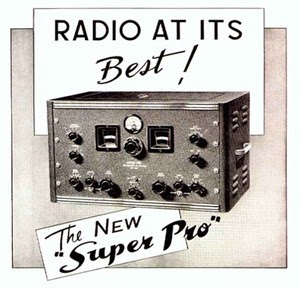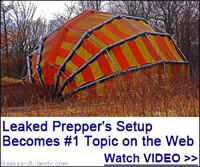Shortwave Radio For Preppers
 by Gaye Levy
by Gaye Levy
A year and a half ago, I asked my friend George Ure at Urban Survival to help with an article on emergency communications. And since he’s the kind of guy who will build you a watch even if all you wanted to know is what the time is, he turned out a really good article which can still be found over on our Strategic Living site.
More recently, as I have started to get serious about both shortwave and HAM radio, I asked him some additional questions during our weekly video conference. What started out as a phone conversation, turned into a lengthy discussion of the whys and the wherefores of shortwave, amateur radio (ham) and the gear to get started.
Why Preppers Need Shortwave Radio
While we all understand the need to have a viable method of communication both during and after a catastrophic emergency, most of us think of a NOAA weather radio first and a shortwave band last. But in reality, both are important.
Widget not in any sidebars
So I asked George: “Practically speaking, why would a person want to have a shortwave radio?”
If America ever had a really worst case kind of event, like an electromagnetic pulse attack, a shortwave radio could get you news and information from halfway around the world. You would have the ability to know what is going on. That could be important if all official news and information sources have been destroyed or damaged.
The same thing would be true if there were massive power failures. As you know, this is not an altogether improbable event.
The other thing – and my favorite reason – is that to some folks, shortwave radio is just plain fun. It gives you a chance to brush up on your trend spotting skills. New music, new politics, new ideas – they often show up first on obscure shortwave stations or satellite television channels.
With that in mind, I am pleased to share the wisdom of George Ure in Part 1 in a two part series on shortwave and HAM radio for newbies.
Revisiting the Magic of Radio – Part 1
Everyone who is serious about communications has their own story of how they just sort of “fell into the hobby” and usually even for a lot of ham radio operators, the saga usually began with something simple.
In my case, it was an old five-tube radio and yes, I’m that old. I had loved to listen to it but there was just something missing. With an external antenna being cobbled up to a tree outside, I discovered that living in Seattle, I could begin to listen to radio stations in distant cities. And one thing led to another and the first thing you know, I was a regular listener to KGO in San Francisco at age 12.
 As cool as that was – to hear local news from a faraway place, it was nothing compared to what happened next. My family home was on the northwest side of Beacon Hill and from the upstairs windows, we could see Elliott Bay. One day while twisting this and that adjustment inside the radio, I discovered that I could hear tugboats talking back and forth out on the bay – and from there I was hooked. This was back when there was still a low frequency marine band down around 3 Megahertz, which is how frequencies are measured these days.
As cool as that was – to hear local news from a faraway place, it was nothing compared to what happened next. My family home was on the northwest side of Beacon Hill and from the upstairs windows, we could see Elliott Bay. One day while twisting this and that adjustment inside the radio, I discovered that I could hear tugboats talking back and forth out on the bay – and from there I was hooked. This was back when there was still a low frequency marine band down around 3 Megahertz, which is how frequencies are measured these days.
Back in the old days, however, radio frequencies were much more self-explanatory: it was cycles per second which really explained the visual concept much more clearly. Political correctness disease again, eh?
Today, those tugboat radios are gone, but not the generations of shortwave fans who evolved from tinkering with other radios. As a matter of fact, these days there are lots of old transistor radios which can be had used for a few dollars at a thrift store that you can tweak on. A radio able to pick up the lower TV audio channels can often be adjusted to hear ham radio as well as low (VHF) band public services.
For preppers, who don’t want to come up through the assorted screwdrivers and learn electronics and get acquainted with the “business end” of a soldering iron, there’s a much easier solution. A wide range of manufacturers have absolutely grand shortwave radios that are very inexpensive.
The Gear: Some Great Radios are Available
My personal (under the pillow at night) radio is the Tecsun PL-660 which you can pick up from Amazon for $130. It’s a really wonderful radio that has all the features a first-time radio user would be shopping for: digital tuning, good selectivity (to separate close stations), an antenna attenuator if you’re not interested in distant (DX) listening.
More sophisticated users will appreciate the synchronous detector which reduces some of the selective fading common to late night/distant stations as well as an assortment of timers for waking up, going to sleep and gobs of memory for storing stations you might wish to refer to in the future.
One thing is does NOT have is the NOAA weather radio channels, but it has better: Aircraft band turning which is always interesting. As I mentioned on my site a while back, every major airport has a service called either AWOS or ATIS which stands for an “automated weather observation system” or “automated terminal information system.” These are continuous broadcasting systems that give wind speed, gusts, visibility, temperatures and other pertinent airport information such as landing light or taxiway lights being out.
Another good radio manufacturer is the C. Crane Company and their CC-Radio-SW which is a few bucks more than the Tecsun and is really aimed at the serious AM/FM market. The built-in “Twin Coil Ferrite® antenna pulls in AM very well and while it’s good for shortwave listening, its tuning steps are 5 KHz where the Tecsun is 1 KHz. In addition, the Tecsun offers selectable sideband operation which means you can listen to the HF ham radio bands which are almost all single sideband, data, and Morse…all of which require a beat frequency oscillator (BFO) to decode.
With these or other shortwave radios, you’ll be able to listen to all the clear channel stations at night such as regional high power AM stations which other stations have to avoid interference with…which is why many AM stations have multiple towers. But there far more exciting listening to be had checking out Radio Japan, listening to news direct from China, the BBC and even Radio Havana, Cuba.
Tens of thousands of Americans became interested in building electronics kits in the 1960s when a company called Heathkit of Benton Harbor, Michigan, had a wide range of kits for do-it-yourselfers. Although the kits didn’t offer the modern features you see today, their ‘Mohican’ was their first all-transistor radio and building those Heathkits (or any other kit) was and is just a heck of a lot of fun.
There is some buzz developing around Heathkit since the company is reorganizing and may introduce new products in the near future according to their FAQ here.
Noise Matters
The most important thing to do before you run out and plop down $100+ for a fine shortwave radio that will last you decades is to use an old, cheap, portable AM radio and go around your house listening in between stations (or better: a marginal weak station) to see how much noise is being generated by appliances in your home.
Most people are shocked to learn how much noise their computer, for example, introduces to the radio environment. If you’re going to do shortwave (or even serious long-distance AM nighttime listening) you’ll need to walk around and figure out where local noise is coming from.
One noise source, which I’ve been fighting with for 50 years is fluorescent light fixtures. Not all of them, but some, make a terrible radio racket. Another one is the typical inexpensive type dimmer switches. One other? Many home computers.
What the dimmer switch uses is a solid-state part that turns the power off and on just some of the time and that switching process can turn benign alternating current into some really ugly square wave pulses and these tend to create “harmonics” which pollute the radio spectrum “from DC to Daylight” as an old radio expression goes.
Usually, the offending appliance or switch can just be turned off and in the event of an actual emergency where you need to get information from a radio station some hundreds of miles distant it’s likely the power being off will clear up reception dramatically! The switching-type power supplies in home computers (even laptops) make the same kind of ugly noise, as do monitors.
One last tool in our “get started” kit would be a copy of the World Radio TV Handbook which, although it will set you back $25 bucks or so, will prove invaluable when you start putting pins in a global map to mark your progress as a shortwave listener trying to hit the shortwave equivalent of the DC Century Club…where hams work to get more than 100 QSL cards – confirmations of contact.
I’d go on for hours about the virtues of listening to the BBC when there’s breaking news, but those are all adventures for you to discover on your own.
All this leads naturally into ham radio which we can talk about next I Part 2.
*****
THE FINAL WORD
When I first started this conversation with George, I asked him to talk about how people can gradually get into emergency communications. He remarked:
Well, that’s an easy one. This being a pleasant time of year, and people are doing a lot of outdoorsy kinds of things, I can’t think of anything better than listening to far away AM radio stations after dark. Watching the sky, seeing the odd shooting star, and tuning around “the bands.”
Fair enough – that is what I get for asking. Next week we get more practical and more tactical with part 2, the Basics of Ham Radio.
Enjoy your next adventure through common sense and thoughtful preparation!




